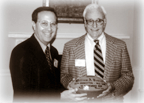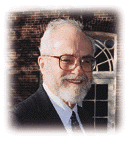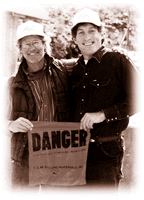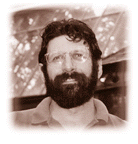Class Notes - January 27, 1999
Class notes features
Insightful philanthropy
 Without World War II, Thomas H. Maren '38 *41 might have ended his days
as a distinguished Ralph Waldo Emerson scholar instead of a distinguished
pharmacologist busy giving away millions in royalties from a top-selling
glaucoma drug. Two years after graduating from Princeton with a chemistry
degree, Maren nearly gave up science entirely, convinced his shortcomings
in mathematics would prevent him from becoming much of a scientist.
Without World War II, Thomas H. Maren '38 *41 might have ended his days
as a distinguished Ralph Waldo Emerson scholar instead of a distinguished
pharmacologist busy giving away millions in royalties from a top-selling
glaucoma drug. Two years after graduating from Princeton with a chemistry
degree, Maren nearly gave up science entirely, convinced his shortcomings
in mathematics would prevent him from becoming much of a scientist.
Maren was a year into a Ph.D. in English, with Emerson a likely dissertation
subject, when the war changed his plans. Like other chemists, he was exempted
from fighting but drafted into war work -- tropical-disease research back
at the Jersey City cosmetics company where he had worked after graduation
developing the hair-removing cream Nair.
In 1943, Maren's war research took him to the Johns Hopkins University,
where he eventually attended medical school, graduating in 1951. Then Maren
returned to industry, as a chemist at American Cyanamid Company in Connecticut.
The boss assigned Maren to study an enzyme called carbonic anhydrase, giving
him the research subject that has preoccupied him ever since.
The fascination has been "the universality of it, the fact that
you saw this system working in many different organs and many different
species but with similar underlying chemistry," Maren says. His work
on inhibiting the action of the enzyme, which plays a role in the formation
of many bodily fluids, helped Cyanamid develop the drug Diamox, still used
to treat glaucoma. Maren's later research -- he has published some 300 scientific
papers, 200 on original work -- has produced not only new drugs but also
new findings in animal physiologyj during 45 summers at the Mount Desert
Island Biological Laboratory near Bar Harbor, Maine, Maren has studied the
enzyme's functioning in dogfish and flounder.
Since 1955, Maren's professional home has been the pharmacology department
at the medical school of the University of Florida at Gainesville -- a medical
school that was so new when he joined its faculty that "the building
wasn't even finished," he remembers. When he retired last June, at
80, Maren had spent 22 years as pharmacology department chair and another
21 as a research professor.
But it was the success of the three-year-old glaucoma drug Trusopt, developed
in partnership with pharmaceutical giant Merck & Company, that gave
Maren a new role -- benefactor. With $127 million in U.S. sales last year,
Trusopt -- an eye drop that does not produce the side effects of the older
drug, Diamox -- accounts for 21 percent of the American market in glaucoma
drugs. The University of Florida licenses the drug to Merck; half the university's
royalties go to Maren. And he's working hard at giving away his surprising
new wealth.
"The last three years have changed everything," Maren says.
"All of a sudden, from a poor kid, I've gone to becoming a minor philanthropist."
Maren has endowed two pharmacology professorships -- a $2-million chair
at Johns Hopkins and part of a $1.8-million chair at the University of Florida
medical school. At Princeton, where his career almost took another path,
Maren sponsors a summer graduate course in contemporary literary theory.
And one of his favorite philanthropies is a club that lets Gainesville-area
schoolchildren buy their own books.
"I like this idea of giving money away," Maren said. "I
chose to do it now, rather than after I'm gone, so I can see it."
-- Deborah Yaffe
A faithful fan
Yale president recognizes a true-blue Tiger
 In New Haven last November 14, Yale President Richard Levin (left) presented
Bill Bours III '39, of Wilmington, Delaware, a football recognizing his
attendance at every Princeton-Yale football game since 1928. Bours was 10
years old when, in the company of his father, Bill Bours, Jr. '04, he watched
his first P-Y contest, played in Palmer Stadium and won by the Tigers 12-2.
Although the inscription on the football (cosigned by Levin and President
Shapiro) credits Bours with 70 P-Y games, he has actually attended 69 --
no game was played in 1944. But who's quibbling? He carries on a tradition
begun by his dad, who saw every P-Y game from 1900 to 1966 (63 in all).
In New Haven last November 14, Yale President Richard Levin (left) presented
Bill Bours III '39, of Wilmington, Delaware, a football recognizing his
attendance at every Princeton-Yale football game since 1928. Bours was 10
years old when, in the company of his father, Bill Bours, Jr. '04, he watched
his first P-Y contest, played in Palmer Stadium and won by the Tigers 12-2.
Although the inscription on the football (cosigned by Levin and President
Shapiro) credits Bours with 70 P-Y games, he has actually attended 69 --
no game was played in 1944. But who's quibbling? He carries on a tradition
begun by his dad, who saw every P-Y game from 1900 to 1966 (63 in all).
Mathematics for the future
Increasing the public's awareness of the role of math
 Felix E. Browder *48, professor of mathematics at Rutgers University,
is president-elect of the 33,000-member American Mathematical Society. He
will take office next month, succeeding another Princetonian, Arthur M.
Jaffe '59 *66 of Harvard.
Felix E. Browder *48, professor of mathematics at Rutgers University,
is president-elect of the 33,000-member American Mathematical Society. He
will take office next month, succeeding another Princetonian, Arthur M.
Jaffe '59 *66 of Harvard.
Browder sees a two-fold mission for the AMS. "We want to promote
the vitality of mathematics by playing an increasingly active role in political
affairs," lobbying in Washington, D.C., for funding for mathematical
education and research. "Nothing happens without money," he points
out.
Browder adds, "We want to develop more visibility for mathematics,
to publicize mathematics and its purpose to the general public." To
the latter end, Browder is principal organizer of an AMS conference to be
held at UCLA in August 2000, "The Mathematical Challenges of the 21st
Century." The gathering will highlight "front-line areas of mathematical
research that have direct, possibly revolutionary application in other areas."
Examples, he says, are chaos theory, data compression, the genome project,
and the mathematics of finance.
Mathematics is increasingly relevant to us all, Browder asserts. "Computers
are fundamentally mathematical, as is biotechnology. The problems of physics
are increasingly mathematical. Finance, in its global complexity, is mathematical.
"The amount of sophisticated mathematics you have to know to do
almost anything, especially anything scientific, has increased dramatically."
Though noted among his peers for achievements that include development
of linear and nonlinear partial differential equations and nonlinear functional
analysis, Browder has always been as much public agent as reclusive theorist.
An active member of AMS committees for many years, as well as chairman at
Chicago for 12 years, he says, "I have never found it difficult to
deal with practical affairs. Basically, I learned to get down to essentials.
It's the busy work and general nonsense that take time and energy.
"I am devoted to carrying forth the cause of mathematics,"
he says. "If that means going to meetings, I go."
His conviction that mathematics is "one of the central elements
of our culture and civilization" was developed as a graduate student.
"That's really what I got from Princeton," he says.
Browder recalls, "Princeton had a very strong effect on me, because
it was much more open than other institutions to some of the major mathematical
currents of the time, such as topology and abstract algebra."
As a graduate student, he heeded the advice of department chair Solomon
Lefschetz: "Go listen to every lecture you possibly can. Even if you
don't understand what's being said, you will learn by osmosis." Absolutely
true, says Browder, "You get a sense of the problems, the background.
It's not the details that are important, but general points of view."
Browder's graduate education occupied a mere two years -- as had his
undergraduate experience at MIT. "I seemed to learn quickly,"
he says. Armed with a Ph.D. at the near-prodigious age of 20, he had some
difficulty finding an academic position -- a circumstance he attributes
to being eldest son of Earl R. Browder, two-time U.S. Communist Party presidential
candidate. "I was the only person to be blacklisted for his father's
former political opinions," Felix Browder says. However, he "got
a tenure-track position at Yale in 1956, and that cleared the air."
He moved to the University of Chicago in 1963 and to Rutgers in 1986.
The senior Browder "discouraged me and my two brothers from taking
an active part in politics, but strongly encouraged our intellectual interests."
That all three brothers became mathematicians -- the others are Princeton
professor William Browder *58 (a former president of the AMS) and Brown
professor Andrew Browder -- is an outcome for which Felix Browder "can
offer no rational explanation."
Certainly Browder's intellectual interests have flourished. "My
great eccentricity from the point of view of the math community," he
confesses, "is my desire to know everything outside of mathematics.
I spend a lot of time reading, and have an enormous collection of books,
approximately 30,000, in all fields."
He is particularly interested in "philosophy and the history of
philosophy, and science and the philosophy and history thereof. I have an
active interest in most of the things going on in science today. And in
most of the controversies in cultural studies.
"And God knows what else."
Browder also has a sense of humor. In his AMS position statement, urging
cooperation among mathematical and scientific associations, he quoted Benjamin
Franklin: "If we do not hang together, we shall surely all hang separately."
-- Caroline Moseley
Films that bring history to the masses
 Longtime hollywood producer Mark Carliner '60 has crafted one of the
most consistently prestigious and successful careers in television films
over the past decade. In 1998 he won a Golden Globe, the George Foster Peabody
Award, the Humanitas award, three CableACE awards and three Emmys for the
four-hour cable film George Wallace, directed by filmmaker John Frankenheimer
(Ronin, The Manchurian Candidate) and starring Gary Sinise
as the controversial former governor of Alabama.
Longtime hollywood producer Mark Carliner '60 has crafted one of the
most consistently prestigious and successful careers in television films
over the past decade. In 1998 he won a Golden Globe, the George Foster Peabody
Award, the Humanitas award, three CableACE awards and three Emmys for the
four-hour cable film George Wallace, directed by filmmaker John Frankenheimer
(Ronin, The Manchurian Candidate) and starring Gary Sinise
as the controversial former governor of Alabama.
Carliner also produced Stalin, the 1992 groundbreaking (and Emmy-
and Golden Globe-winning) historical film for HBO chronicling the life of
the infamous Soviet leader. The film was shot entirely in Russia and includes
scenes shot in Stalin's offices and living quarters. Carliner is now developing
a film detailing the life of Fidel Castro.
It's rare to find a Hollywood producer who actually tackles historical
subjects for a mass medium like television, but it's rarer still to find
one so passionate about his projects that he does the research for the films
and works on the scripts himself. "In a strange, wonderful way,"
says Carliner, "it was the training I got at Princeton that has made
all this possible."
At Princeton, Carliner graduated Phi Beta Kappa and magna cum laude
in history, a discipline he handled so well that his thesis adviser strongly
recommended that Carliner teach for a living. "It's wonderful for me
now to think that all these years later I'm finally teaching history,"
Carliner says, "except my classroom is a lot bigger than any at Princeton
or any other university."
Carliner's first film was Viva Max!, with Peter Ustinov, in 1968.
He also produced Heaven Help Us (1984) and Crossroads (1986).
But he found his true calling in producing socially conscious movies for
television, such as a film about antisemitism that he made for NBC in 1988.
"The original title was The Education of Beth Vincent,"
Carliner recalls about the film, which starred Raquel Welch, "but the
head of NBC, Brandon Tartikoff, said, 'no one's going to watch a movie with
that title.'" So Tartikoff changed it to the much more suggestive Scandal
in a Small Town, and the film became NBC's highest-rated movie of the
year.
Carliner's next film, a movie for ABC called Disaster at Silo 7,
a true story about a Titan II missile that blew up in its silo near Little
Rock, Arkansas, aired on Thanksgiving weekend in 1988 and was seen by members
of a visiting high-level Russian delegation (including a Russian film critic)
that happened to be in America at the time. A month later, Carliner received
a call from Russia saying that Gorbachev had seen the film and was inviting
Carliner to televise the movie all across the Soviet Union. "The old
Soviet Union was a producer's dream," Carliner recalls. "On that
January day in 1989, when the picture played in 11 time zones, I had a 100
percent share, because it was the only thing on television. Everybody watched
it because there was nothing else to watch!"
Carliner's film was a Soviet sensation, and the producer became so well
respected that he sensed the opportunity to do more. "I thought, maybe
I could do a movie about Stalin and actually shoot it in Russia," he
explains, and eventually the Soviet government did allow him full access
to the most restricted areas used by Stalin. But one of the most helpful
contributions for the film was actually back in California. "When I
was doing Stalin, I went down into the basement of my house and pulled
out some of the books I used for my senior thesis."
ENJOYING THE RESEARCH
The pleasure for Carliner comes from forming the projects and shaping
storylines based on historical facts, a skill he credits completely to Princeton.
"How many people are able to do what really excited them in college?
I love it. It's the same joy I experienced sitting in my carrel in Firestone
Library doing all my research on Disraeli and not even being aware of the
time going by! I would do it if I weren't getting paid."
But paid he is, particularly for his much more lucrative and commercially
successful collaborations with Stephen King, such as 1997's The Shining,
which he produced as a miniseries so that King could finally realize his
vision of a much longer and more faithful adaptation than Stanley Kubrick's
chilling classic film from 1980, which the bestselling author never really
admired. King was so satisfied with the enormous success of the new Shining
and so happy working with Carliner that the two spent 1998 making Storm
of the Century, a $35-million ABC miniseries to be aired next month.
The story follows a small town on an island off the coast of Maine, which
10 years before suffered an unspeakable horror. When the island gets cut
off by a severe storm, the villagers are trapped with a mysterious stranger
who knows the intimate details of everyone's most shameful secret, and who
won't leave until they give him everything he wants. "It's the first
time that Stephen King has ever written an original miniseries," says
Carliner. "It's not an adaptation. He's had 35 movies made from his
material, believe it or not, but Steve believes this could very well be
the very best of all of them. This is popular entertainment, but of the
very highest level. It is a very, very smart piece."
-- Stephen Garrett '92
The Jersey Devil makes them do it
A group of architects and builders use landscape to inspire and inform
their work
 The snail house was taking shape one day in 1972 when a passerby stopped
at the Forked River, New Jersey, construction site to gape.
The snail house was taking shape one day in 1972 when a passerby stopped
at the Forked River, New Jersey, construction site to gape.
"It looks like something the Jersey Devil would do," he commented.
That tactless evocation of a local legend -- the Pine Barrens monster
who emerges periodically to wreak havoc -- might have annoyed many architects.
But not the creators of the spiraling Snail House. Steve Badanes *71, a
new graduate of the School of Architecture, and his classmate John Ringel
*71, who had left the architecture program without a degree, "really
were tickled by the idea," Ringel says. They promptly christened their
fledgling architectural collaboration Jersey Devil.
 In the decades since, Badanes and Ringel --
joined three years later by Jim Adamson '70 -- have produced their share
of whimsical work. They have built houses that bear more than a passing
resemblance to a football, a medieval knight's helmet, and a hero sandwich,
as well as a snail. They have created light fixtures out of Nerf balls and
flower pots. They have welcomed a "Weird Home Award" from The
National Enquirer and a bad review from The New York Times.
In the decades since, Badanes and Ringel --
joined three years later by Jim Adamson '70 -- have produced their share
of whimsical work. They have built houses that bear more than a passing
resemblance to a football, a medieval knight's helmet, and a hero sandwich,
as well as a snail. They have created light fixtures out of Nerf balls and
flower pots. They have welcomed a "Weird Home Award" from The
National Enquirer and a bad review from The New York Times.
But more important, Jersey Devil -- which remains a loosely knit collaboration,
with sometimes one, sometimes two, sometimes all three men working on a
project -- has tried to honor ideals forged in the hopeful rebellion of
the 1960s and early '70s. Unlike most architects, Jersey Devil builds its
own designs, bucking a tradition so entrenched that it was not until 1978
that the American Institute of Architects lifted a ban on design-build.
Jersey Devil got around that ban because its partners are not licensed architects;
when necessary, their plans are reviewed by associates who are.
 "I actually was a bit disappointed about architecture
when I graduated," says Adamson, an undergraduate architecture major.
"I felt that it was too isolated from the reality of building. You've
got to teach kids to know what a two-by-four is and how to cut it and how
to put it into a construction. You have to have practical understanding."
"I actually was a bit disappointed about architecture
when I graduated," says Adamson, an undergraduate architecture major.
"I felt that it was too isolated from the reality of building. You've
got to teach kids to know what a two-by-four is and how to cut it and how
to put it into a construction. You have to have practical understanding."
To make design-build feasible, Jersey Devil's collaborators live at the
building site during construction, observing the position of the sun, the
prevailing winds, the best views. For years, Badanes camped in a vintage
Airstream trailer, which finally bit the dust five years ago, after its
gas line caught fire on a California roadway. On his first Jersey Devil
project, the 1975 Silo House in Lambertville, New Jersey, Adamson built
himself a waterproof hut by varnishing the cardboard boxes the new windows
had come in.
"The longer you stay there, the more you're going to know about
the site, and the more the building can respond to it," Adamson says.
The buildings that grow out of this process are intended to be well-crafted,
energy-efficient, and environmentally responsible (and these days, Badanes
said, they are unlikely to resemble footballs or sandwiches.) A house that
Adamson and Badanes are building now in Palm Springs, California, will include
a bamboo-covered ceiling, because that wood -- unlike, say, mahogany from
the rain forest -- replenishes itself within three years. A Montessori school
the two men designed stays cool without air conditioning -- in Florida.
"People don't think we're going to run out of resources. It's gone
out of fashion to worry about it," Ringel says. "But we will run
out if we're not careful."
The work of Jersey Devil has inspired two books, most recently Devil's
Workshop: 25 Years of Jersey Devil Architecture, by Susan Piedmont-Palladino
and Mark Alden Branch (Princeton Architectural Press, 1997). And the romance
of Jersey Devil -- guys in trailers, camping out in the dead of winter,
building houses that don't guzzle fuel oil, serving a vanishing vision --
"is very strong among students," says Badanes, who now spends
part of the year as a professor of architecture at the University of Washington
at Seattle.
"It's an idealistic way to live," Badanes says. "In terms
of fantastic creation and interesting lifestyle and dedication and social
responsibility -- it combines all that stuff. And it looks like fun. It
is fun."
-- Deborah Yaffe
Restoring a bit of Princeton's past
 When Avril and Tom Moore (both '73) were undergraduates they used to
fantasize about living in the town of Princeton -- "beyond the gates,"
as Avril puts it, "with a house and a car."
When Avril and Tom Moore (both '73) were undergraduates they used to
fantasize about living in the town of Princeton -- "beyond the gates,"
as Avril puts it, "with a house and a car."
Now after 20 years of life in Cincinnati, where Tom was with Procter
and Gamble, he has taken a job as CEO of Nelson Communications, a communications
and consulting firm in the health-care field. They are back in Princeton,
ensconced in a house rich in association with the university -- John Witherspoon's
country home, Tusculum, which they have restored and expanded with lavish
attention to detail.
 When they came from Cincinnati to look for a house, Tom had said it
had to be close to town, not a fixerupper, with a low-maintenance yard.
After the real estate agent showed them 34 houses in a day and a half and
nothing suited them, she in desperation took them to Tusculum, a house on
58 acres of neglected land, with a leaky roof and rotten floors. Avril was
distressed that to get to three of the bedrooms you had to go through a
bathroom.
When they came from Cincinnati to look for a house, Tom had said it
had to be close to town, not a fixerupper, with a low-maintenance yard.
After the real estate agent showed them 34 houses in a day and a half and
nothing suited them, she in desperation took them to Tusculum, a house on
58 acres of neglected land, with a leaky roof and rotten floors. Avril was
distressed that to get to three of the bedrooms you had to go through a
bathroom.
Tom went through the house and stood on the front porch, looked out at
the trees, the geese, and the deer, and said, "I like it. I want to
live here the rest of my life." At that point, he knew only that John
Witherspoon had been a Presbyterian preacher, president of Princeton, and
a signer of the Declaration of Independence. He has since learned a lot
more.
Before they could buy it, the Moores had to satisfy the seller and the
Historic Preservation Commission of the Township of Princeton that they
would live in the house and restore it faithfully. The fact that they had
restored a big Victorian house in Cincinnati gave them credibility.
It took a year to get all the approvals they needed and another year
to do the renovations, which went on under the watchful eye of the Preservation
Committee. The main part of the house was built of stone in 1773, a stonefaced
wing was added in the 1830s, and two other wings were added in the 1920s.
The Moores' extensive renovations restored the original home and the 1830s
addition and ripped out the 20th-century additions and replaced them with
two brand new wings.
They had to rebuild the original house. They removed four different roofs,
one on top of the other, and put on a new one. The most recent, a slate
roof, was too heavy for the house and had caused sagging. They shored up
beams and leveled them. A new foundation had to be created because excavation
showed the house was built on rock rubble.
Termites and powder post beetles had destroyed virtually all the floors
except those in the attic, which had been protected by paint. The Moores
ripped out the downstairs floors and replaced some of them with boards from
the attic and others with boards cut from logs that had been under water
on a Maryland wharf. "That's where all the wood comes from nowadays
for restorations," Avril says.
It all cost millions. "A house like this is a responsibility,"
says Tom cheerfully.
Avril and their three children lived in a rented house while all this
was going on. When the owner wanted to sell the rented house before the
builders had finished with Tusculum, Tom sent Avril and the kids to their
summer home in Chatauqua, New York, while he stayed behind in hotels in
Princeton and New York. "I kept my clothes in the trunk of my car,'
he said. "I was like a street person."
In August, they all moved into a restored, enlarged, splendid Tusculum,
carefully decorated, with 26 or 28 rooms -- Avril doesn't seem sure herself.
To the right of the front door is a "rod and reel room" that
was Witherspoon's study. "The British took all his books from this
room and burned them," says Tom. On the left is a huge dining room
and a sitting room. In one new wing are two bedrooms, and in the other,
a new kitchen with an Aga stove. Also new is a room big enough for dancing
that stretches across the back of the house. Its windows look out over the
fenced area that's to be a garden and a home for four sheep sent by four
friends of Tom's from Cincinnati.
On the second floor, the original drawing room has been restored to its
former elegance with its five nineonninepane windows opening across the
front of the house. (Previous owners had cut the big room into two bedrooms.)
Also on the second floor is a computer room, a study for Tom, an office
for Avril, and three more bedrooms. There are countless other sitting rooms,
including a card room, scattered here and there.
In the attic is a carpeted rumpus room with a movie screen and projector.
The basement is awe inspiring. It contains not only a wine cellar with bins
for 1,500 bottles of wine, but also a wine-tasting room with a big table
and narrow granite ledges around the walls so that tasters can set glasses
on them.
Outside, the Moores replaced the trees forming the allée from
Cherry Hill Road to the house with zelkova elms. The huge barn could perhaps
someday become a theater. An apple orchard spreads out on a hill, and farther
on are cherry and pear trees and one plum tree. Witherspoon, a dour Scot,
might have disapproved of the pool and tennis court, but he'd have liked
the pond and the sheep.
-- Ann Waldron
Where Go goes, she goes
 When British Airways called a press conference in November 1997 to announce
Go -- its new low-cost airline -- Go CEO Barbara Cassani *84 wondered whether
the press would be interested. She needn't have worried. Since its first
flight took off on May 22, 1998, Go and Cassani have been the subjects of
intense media scrutiny. On the one hand, Cassani's efforts to start up a
quality low-cost airline in the newly deregulated European market were applauded:
in July 1998 the London Times named Cassani "one of the 100
men and women who will be the movers and shakers of the next decade."
At the same time, British Airways (BA) has been accused of cutting fares
and running Go at a loss to put other low-cost airlines out of business.
When British Airways called a press conference in November 1997 to announce
Go -- its new low-cost airline -- Go CEO Barbara Cassani *84 wondered whether
the press would be interested. She needn't have worried. Since its first
flight took off on May 22, 1998, Go and Cassani have been the subjects of
intense media scrutiny. On the one hand, Cassani's efforts to start up a
quality low-cost airline in the newly deregulated European market were applauded:
in July 1998 the London Times named Cassani "one of the 100
men and women who will be the movers and shakers of the next decade."
At the same time, British Airways (BA) has been accused of cutting fares
and running Go at a loss to put other low-cost airlines out of business.
Cassani, who has worked for BA in a number of capacties since 1987, took
charge of Go in the spring of 1997, when BA asked her to look into the idea
of entering the low-cost market. In November 1997, Go received a one-shot
equity injection from BA. Cassani has seen the airline through its fledgling
stages into a period of expansion (Go has seven aircraft flying from London's
Stanstead Airport to nine European cities), and she talks about her vision
for Go with infectious enthusiasm: "I've always thought, where's the
airline brand equivalent of Swatch, Ikea, or Gap? You either fly on a top-end
world-class airline or on some terrible airline thinking, 'I don't really
want to be here!' There's no Gap airline. Why not?" She explains that
a lot of what makes airlines good isn't cost-related -- "it's selecting
the right people, having an upbeat tone. I could see that from the second
this idea was thrown to me."
Cassani's vision is evident at every level of the company -- from its
eye-catching polychrome print ad campaign to the employees' stylish casual
dress. At company headquarters, the reception area resembles a trendy coffee
bar with chrome tables and brightly colored couches. "You don't need
specific qualifications to work here," explains a receptionist fielding
calls from prospective employees. "You just need to be customer-focused."
"We're always thinking about the customer," says Cassani, who
writes up to 15 letters a day to customers. "I spend time on understanding
why someone was happy or unhappy with the service." She's implemented
a policy of being straightforward with customers. Telephone staff ask customers
whether their schedules are flexible so they can get the cheapest fares.
Cabin crew explain flight procedures without using jargon. "In this
industry people obscure very straightforward issues. For example, you don't
disembark a plane. You get off. Our cabin crews speak to people the way
they'd speak on the street."
Cassani says she's surprised by her media profile -- which she explains
as being peculiar to Britain, where few women are in top management positions.
"In the States a woman running an airline wouldn't be such a big deal.
The publicity's a little odd -- but if it helps the sales or the company's
image, it's O.K." And though she doesn't directly address allegations
that Go operates at a loss, she does point out that her job is to "turn
the business to a profit in the confines of the equity received from BA."
If other airlines do go out of business in the future, she says, that industry
consolidation may be a natural outcome of worldwide industry deregulation.
And what's in the future for Cassani? The Times suggested she's
a strong candidate for future chief executive of BA -- and living in England
suits her family (she's married to an Englishman she met at Princeton, and
has two small children). But her background is broad -- she majored in politics
at Mount Holyoke, completed an MPA at the Woodrow Wilson School, and worked
as a management consultant for Coopers Lybrand before joining BA -- and
she feels she hasn't yet lived up to her commitment to public service. "One
thing I like about being American is I could be appointed to a job in Washington
some day. Who knows?"
-- Tamsin Todd '92
Speaking for Al Gore
 For most of 1998, the top press spokesmen for the two most powerful
men in America were Princetonians. One, Mike McCurry '76, was on the evening
news almost every night serving as President Clinton's public face. The
other -- Vice-President Al Gore's communications director, Lawrence J. Haas
*80 -- was rarely seen by the public.
For most of 1998, the top press spokesmen for the two most powerful
men in America were Princetonians. One, Mike McCurry '76, was on the evening
news almost every night serving as President Clinton's public face. The
other -- Vice-President Al Gore's communications director, Lawrence J. Haas
*80 -- was rarely seen by the public.
Both, however, decided to relinquish their posts in late 1998. It would,
of course, be folly to suggest those decisions had nothing to do with the
exhaustion and frustration of dealing with Washington's 24-hour media maelstrom,
most obviously the Monica Lewinsky matter.
"It's dicey," Haas says in an interview in the Old Executive
Office Building, the stately edifice located a stone's throw from the White
House. "I know I'm not the only one who feels this way, but I find
myself weighing my words out of real caution about being caught. When I
say 'being caught,' I mean having someone use something I have not phrased
as artfully as I could have if I'd had more time, then using it against
me or -- more importantly -- the President or Vice-President."
Haas, as both a seasoned journalist and a history buff, realizes that
overheated media scrutiny is not unprecedented in American history. A native
of Long Island, New York, Haas, now 42, studied American history at the
University of Pennsylvania and later earned a master's degree in the same
subject at Princeton, studying under two famed modern American historians,
Arthur Link and Eric Goldman. [See page 72.] Haas says that his academic
background helped him both as director of communications in Clinton's Office
of Management and Budget (a job he held from 1994 to early 1998) and later
with Gore, who -- Haas says -- also fancies himself a student of history.
"The great thing about knowing history," he says, "is
having perspective -- for instance, not proclaiming that something that
happened that day is unprecedented, because it probably isn't. It helped
me to appreciate the fact that FDR's White House was kind of a laboratory
of experimentation. People criticized President Clinton for being disorganized,
but the Roosevelt White House was disorganized for quite the same reason.
Both of them were run by very interesting, broad-minded individuals who
were determined to address the country's problems. Doing that kind of work
is not always neat and organzied."
While Haas escaped most of the scandal flak during his stint at OMB,
he has faced for most of this year "a constant series of questions,
from the reasonable to the ludicrous -- the reasonable ones being, 'What
does the Vice-President think of the situation?' and the ludicrous ones
being, 'Aren't you meeting now to discuss the transition of Clinton to Gore?'
I've gotten that one dozens of times."
The plethora of "wooden Gore" jokes aside, Haas describes the
Vice-President as "truly hysterical. He has a very dry wit. He's extraordinarily
bright, very thoughtful, and can be quite charming. He's also very exacting
in his standards -- and impatient when people don't meet them."
Haas considers himself "more cautious" than McCurry, who is
"more likely to throw off a one-liner for the record than I am."
But Haas adds that McCurry is probably his most important role model. "Someone
in my position needs to understand and appreciate the very difficult job
the press has to do. If you help them do it, that will ultimately come back
to the principle you're trying to serve. Not everyone understands that around
here -- some of my colleagues say spokesmen should be in a constant state
of warfare with the press. I don't believe that, and Mike McCurry doesn't
believe that either."
Now that Haas has decided to retreat into the private sector, he won't
be able to step directly into McCurry's shoes -- that is, assuming that
Gore runs for the presidency and manages to win in 2000.
"I don't have any regrets" about possibly missing out on the
Gore Administration, he says. "It's been a great four-year run. I've
seen things I never imagined I'd see. I've gotten to know the President
a bit, and the First Lady, the Vice-President, and Mrs. Gore a bit better.
I've spent time in the Oval Office, the Cabinet Room, the Roosevelt Room,
the Chief of Staff's office. I've traveled all over the country on Air Force
Two with the Vice-President. I would sound a bit spoiled if I had any regrets
after having experienced that."
-- Lou Jacobson '92
Louis Jacobson is a staff correspondent at National Journal
magazine in Washington.
Making concessions a business
 For most people, a crowded airport with throngs of travelers in the
waiting areas is an unwelcome sight. Not for Charles Hopkins '89.
For most people, a crowded airport with throngs of travelers in the
waiting areas is an unwelcome sight. Not for Charles Hopkins '89.
Hopkins is chairman and CEO of RMD Concessions, a growing chain of stores
located in three large airports and moving into three others. RMD's staples
-- newspapers, magazines, candy, and other convenience items -- are the
everyday items travelers just can't do without.
The company, a partnership run with a friend Hopkins met while working
at J.P. Morgan & Co. in New York, actually began as something very different.
Its initials come from its original name, Reliable Minority Distributors,
which was formed six years ago to supply computer equipment to Atlantic
City casinos. That proved a struggle. "We found that even with the
opportunities available to minorities, it was hard to compete against the
Stapleses of the world," Hopkins says.
The airport concession business has proven far friendlier. RMD set up
its first store at JFK International Airport in New York in 1995 and by
1998 had grown to nine locations in three East Coast airports -- JFK, Boston's
Logan, and Ronald Reagan Washington National -- with seven other stores
scheduled to open by last December. The company employs 38 full-time workers
and many more part-timers; gross revenues hit $6 million in 1997 and should
top $11.5 million in 1998, Hopkins says. The biggest piece consists of eight
Press Relay news and gifts stores; RMD's recent plans included opening a
bookstore in the Orlando airport and a specialty store in Richmond, and
launching five Wilson's Leather stores at Chicago's O'Hare Airport.
The O'Hare project is a joint venture with Wilson's Leather, a sizable
national chain. "One of our strategies all along has been to approach
bigger players and couple our efforts and strategies to win more contracts,"
Hopkins says.
The business is run out of a small office close to Hopkins's home in
Silver Spring, Maryland, but there are also offices in each airport. Keeping
on top of things involves plenty of traveling, but Hopkins and his partner
split the load. "We've adopted something of a divide-and-conquer strategy,"
he says. "And it helps to have good district managers."
Hopkins, who was a cum laude graduate in politics, earned an MBA
from the Wharton School in 1991 and, like many classmates, gravitated to
Wall Street. He worked at Morgan and then at Alex. Brown & Sons (now
BT Alex Brown) in Baltimore, where exposure to merger advisory work in consumer
products and retail industries piqued his interest "in high-traffic
transportation venues" like airports.
A likely economic slowdown doesn't faze him. "If business travel
reduces a couple of clicks, so be it. Newspapers are a staple -- you've
got to keep up with what's going on." Hopkins adds, "I think travel
in general is increasing, and we'll take advantage of that. And a slowing
economy also gives us more opportunities to pursue acquisitions."
-- Jeffrey Marshall '71
paw@princeton.edu
 Without World War II, Thomas H. Maren '38 *41 might have ended his days
as a distinguished Ralph Waldo Emerson scholar instead of a distinguished
pharmacologist busy giving away millions in royalties from a top-selling
glaucoma drug. Two years after graduating from Princeton with a chemistry
degree, Maren nearly gave up science entirely, convinced his shortcomings
in mathematics would prevent him from becoming much of a scientist.
Without World War II, Thomas H. Maren '38 *41 might have ended his days
as a distinguished Ralph Waldo Emerson scholar instead of a distinguished
pharmacologist busy giving away millions in royalties from a top-selling
glaucoma drug. Two years after graduating from Princeton with a chemistry
degree, Maren nearly gave up science entirely, convinced his shortcomings
in mathematics would prevent him from becoming much of a scientist. In New Haven last November 14, Yale President Richard Levin (left) presented
Bill Bours III '39, of Wilmington, Delaware, a football recognizing his
attendance at every Princeton-Yale football game since 1928. Bours was 10
years old when, in the company of his father, Bill Bours, Jr. '04, he watched
his first P-Y contest, played in Palmer Stadium and won by the Tigers 12-2.
Although the inscription on the football (cosigned by Levin and President
Shapiro) credits Bours with 70 P-Y games, he has actually attended 69 --
no game was played in 1944. But who's quibbling? He carries on a tradition
begun by his dad, who saw every P-Y game from 1900 to 1966 (63 in all).
In New Haven last November 14, Yale President Richard Levin (left) presented
Bill Bours III '39, of Wilmington, Delaware, a football recognizing his
attendance at every Princeton-Yale football game since 1928. Bours was 10
years old when, in the company of his father, Bill Bours, Jr. '04, he watched
his first P-Y contest, played in Palmer Stadium and won by the Tigers 12-2.
Although the inscription on the football (cosigned by Levin and President
Shapiro) credits Bours with 70 P-Y games, he has actually attended 69 --
no game was played in 1944. But who's quibbling? He carries on a tradition
begun by his dad, who saw every P-Y game from 1900 to 1966 (63 in all). Felix E. Browder *48, professor of mathematics at Rutgers University,
is president-elect of the 33,000-member American Mathematical Society. He
will take office next month, succeeding another Princetonian, Arthur M.
Jaffe '59 *66 of Harvard.
Felix E. Browder *48, professor of mathematics at Rutgers University,
is president-elect of the 33,000-member American Mathematical Society. He
will take office next month, succeeding another Princetonian, Arthur M.
Jaffe '59 *66 of Harvard. Longtime hollywood producer Mark Carliner '60 has crafted one of the
most consistently prestigious and successful careers in television films
over the past decade. In 1998 he won a Golden Globe, the George Foster Peabody
Award, the Humanitas award, three CableACE awards and three Emmys for the
four-hour cable film George Wallace, directed by filmmaker John Frankenheimer
(Ronin, The Manchurian Candidate) and starring Gary Sinise
as the controversial former governor of Alabama.
Longtime hollywood producer Mark Carliner '60 has crafted one of the
most consistently prestigious and successful careers in television films
over the past decade. In 1998 he won a Golden Globe, the George Foster Peabody
Award, the Humanitas award, three CableACE awards and three Emmys for the
four-hour cable film George Wallace, directed by filmmaker John Frankenheimer
(Ronin, The Manchurian Candidate) and starring Gary Sinise
as the controversial former governor of Alabama. The snail house was taking shape one day in 1972 when a passerby stopped
at the Forked River, New Jersey, construction site to gape.
The snail house was taking shape one day in 1972 when a passerby stopped
at the Forked River, New Jersey, construction site to gape. In the decades since, Badanes and Ringel --
joined three years later by Jim Adamson '70 -- have produced their share
of whimsical work. They have built houses that bear more than a passing
resemblance to a football, a medieval knight's helmet, and a hero sandwich,
as well as a snail. They have created light fixtures out of Nerf balls and
flower pots. They have welcomed a "Weird Home Award" from The
National Enquirer and a bad review from The New York Times.
In the decades since, Badanes and Ringel --
joined three years later by Jim Adamson '70 -- have produced their share
of whimsical work. They have built houses that bear more than a passing
resemblance to a football, a medieval knight's helmet, and a hero sandwich,
as well as a snail. They have created light fixtures out of Nerf balls and
flower pots. They have welcomed a "Weird Home Award" from The
National Enquirer and a bad review from The New York Times. "I actually was a bit disappointed about architecture
when I graduated," says Adamson, an undergraduate architecture major.
"I felt that it was too isolated from the reality of building. You've
got to teach kids to know what a two-by-four is and how to cut it and how
to put it into a construction. You have to have practical understanding."
"I actually was a bit disappointed about architecture
when I graduated," says Adamson, an undergraduate architecture major.
"I felt that it was too isolated from the reality of building. You've
got to teach kids to know what a two-by-four is and how to cut it and how
to put it into a construction. You have to have practical understanding." When Avril and Tom Moore (both '73) were undergraduates they used to
fantasize about living in the town of Princeton -- "beyond the gates,"
as Avril puts it, "with a house and a car."
When Avril and Tom Moore (both '73) were undergraduates they used to
fantasize about living in the town of Princeton -- "beyond the gates,"
as Avril puts it, "with a house and a car." When they came from Cincinnati to look for a house, Tom had said it
had to be close to town, not a fixerupper, with a low-maintenance yard.
After the real estate agent showed them 34 houses in a day and a half and
nothing suited them, she in desperation took them to Tusculum, a house on
58 acres of neglected land, with a leaky roof and rotten floors. Avril was
distressed that to get to three of the bedrooms you had to go through a
bathroom.
When they came from Cincinnati to look for a house, Tom had said it
had to be close to town, not a fixerupper, with a low-maintenance yard.
After the real estate agent showed them 34 houses in a day and a half and
nothing suited them, she in desperation took them to Tusculum, a house on
58 acres of neglected land, with a leaky roof and rotten floors. Avril was
distressed that to get to three of the bedrooms you had to go through a
bathroom. When British Airways called a press conference in November 1997 to announce
Go -- its new low-cost airline -- Go CEO Barbara Cassani *84 wondered whether
the press would be interested. She needn't have worried. Since its first
flight took off on May 22, 1998, Go and Cassani have been the subjects of
intense media scrutiny. On the one hand, Cassani's efforts to start up a
quality low-cost airline in the newly deregulated European market were applauded:
in July 1998 the London Times named Cassani "one of the 100
men and women who will be the movers and shakers of the next decade."
At the same time, British Airways (BA) has been accused of cutting fares
and running Go at a loss to put other low-cost airlines out of business.
When British Airways called a press conference in November 1997 to announce
Go -- its new low-cost airline -- Go CEO Barbara Cassani *84 wondered whether
the press would be interested. She needn't have worried. Since its first
flight took off on May 22, 1998, Go and Cassani have been the subjects of
intense media scrutiny. On the one hand, Cassani's efforts to start up a
quality low-cost airline in the newly deregulated European market were applauded:
in July 1998 the London Times named Cassani "one of the 100
men and women who will be the movers and shakers of the next decade."
At the same time, British Airways (BA) has been accused of cutting fares
and running Go at a loss to put other low-cost airlines out of business. For most of 1998, the top press spokesmen for the two most powerful
men in America were Princetonians. One, Mike McCurry '76, was on the evening
news almost every night serving as President Clinton's public face. The
other -- Vice-President Al Gore's communications director, Lawrence J. Haas
*80 -- was rarely seen by the public.
For most of 1998, the top press spokesmen for the two most powerful
men in America were Princetonians. One, Mike McCurry '76, was on the evening
news almost every night serving as President Clinton's public face. The
other -- Vice-President Al Gore's communications director, Lawrence J. Haas
*80 -- was rarely seen by the public. For most people, a crowded airport with throngs of travelers in the
waiting areas is an unwelcome sight. Not for Charles Hopkins '89.
For most people, a crowded airport with throngs of travelers in the
waiting areas is an unwelcome sight. Not for Charles Hopkins '89.